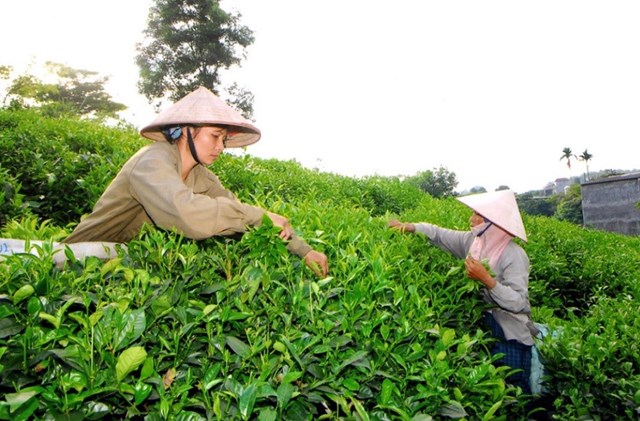Source: kinhtedouong.vn
1. Thai Nguyen tea industry position
Thai Nguyen has long been known as Vietnam’s tea capital, with a total tea growing area now reaches over 22,200 hectares, fresh bud production every year is more than 272,000 tons, and the value of tea products is estimated. reaching about 13,800 trillion dong. This is a locality with the largest area, productivity, output and economic value from the tea tree in the country, playing an important role in the development of Vietnam’s tea industry.

Artwork
In order to improve the quality of products and develop tea industry in a sustainable way, Thai Nguyen has issued many policies to support tea growers such as supporting organic fertilizer, biology, safe production certification according to standards. VietGAP, organic, application of water -saving irrigation systems, and mechanization of tea production and processing process.
2. Conversion of tea breed structure
From 2021 to now, Thai Nguyen province has converted more than 1,700 hectares of tea to varieties with high productivity and quality. Currently, more than 82.8% of tea area in the whole province are new tea varieties such as LDP1, Kim Tuyen, Huong Bac Son, Tri777, Tri5.0, Bat Tien, Phuc Van Tien, LCT1, PH1, PH12, PH14, VN15 … These tea varieties have low tannin content, typical aroma, suitable for diverse processing of high -class tea products.
In addition, about 17% of the remaining tea area belongs to the midland tea variety – a high tanin, taste and sweet taste, most suitable for traditional green tea processing. This type of tea is grown mainly in famous tea areas such as Xinjiang (Thai Nguyen City), La Bang (Dai Tu district), Khe Coc – instant Tranh (Phu Luong district).
3. Application of science and technology in tea production
In order to improve product quality, Thai Nguyen has promoted the application of scientific and technological advances in production. Currently, over 7,000 hectares of tea applies automatic and semi -automatic watering technology, accounting for more than 30% of tea area in the province. In addition, more than 5,900 hectares of tea have been certified safe production according to VietGAP and organic standards, accounting for 26.6% of the total tea area of the province.
Notably, the province has granted 62 codes of tea growing areas with GPS to trace products, creating a premise to expand export markets. At the same time, the province continues to support tea growing households to register for planting areas according to international standards to meet the requirements of the domestic and international markets.
4. Improve processing capacity and diversify tea products
The whole province currently has 62 companies, tea manufacturing and processing enterprises, 168 cooperatives, 251 traditional trade villages and over 91,000 households making tea. Processing tea output is more than 54,600 tons/year, of which, green tea accounts for about 80%, the rest are black tea products, pink tea, matcha, kombucha, shake tea …
Tea production establishments are increasingly focusing on modern processing technology such as using stainless steel corrugated iron, gas stars, and automatic electric tea machines. The packaging and storage system is also improved with a vacuum machine, automatic packaging machine, incense incubator and refrigeration storage to improve product quality.
5. Brand construction and market expansion
Thai Nguyen currently has 193 tea products meeting OCOP standards from 3 to 5 stars, 47 tea production and trading establishments that are certified for safe food supply chain. The province has been granted a geographical indication “Xinjiang” and 10 collective brands for tea products.
In addition, the collective brand “Thai Nguyen tea” has been protected in 6 countries and territories including the US, China, Russia, Japan, Korea and Taiwan. Brand protection helps improve export value and enhance opportunities to expand the international tea market.
6. Tea industry development goals for the period 2025 – 2030
Thai Nguyen aims to 2030:
Enhancing the province’s tea area to 24,500 hectares.
The output of fresh bud tea reaches over 300,000 tons/year.
70% of tea area is certified manufactured according to GAP and organic standards.
70% of the tea area is granted the planting area code.
100% of tea production, processing and trading establishments ensure food safety regulations.
At least 250 tea products meet OCOP standards from 3 to 5 stars.
To achieve these goals, Thai Nguyen province will continue to review and plan tea growing areas according to GAP, organic, digitizing production areas, promoting the application of technology in processing and commercialization product.
7. Tea tourism development
In addition to production development, Thai Nguyen also focuses on exploiting cultural, historical and tourism values of tea areas. Ecological tourism models, experiences associated with tea areas are being expanded to enhance the brand value of “Thai Nguyen tea” and promote local tourism potential.
The combination of tea and tourism development will help raise the value of tea products, create additional income for people and contribute to promoting the image of Thai Nguyen tea to the world.
With strategic orientations and methodical investment, Thai Nguyen is gradually improving the quality of tea industry, towards sustainable production, improving added value and expanding export markets. In the period of 2025 – 2030, Thai Nguyen tea industry not only continues to maintain its position in the country but also reach out to the world, affirming the brand “Thai Nguyen tea” on the global tea map.
